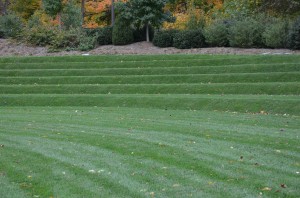Within many garden circles, conventional wisdom says that you should mow lawns very close heading into winter. Mowing height should be adjusted by seasonal and current weather conditions. Mowing height also sets the shoot to root ratio of specific grass species. In cooler northern areas bluegrass and tall fescue are the lawn grasses of choice. In the mid-South (called the “transition zone”) tall fescues and warm season bermudagrass and zoysia are favored.
Cutting height changes with the season. During a hot dry summer mowing height should be raised an additional 1/2 to 1 inch from the spring cut. Just an increase of 1/8 inch inputs more light to individual grass plants and deeper rooting depth. The result: your lawn becomes more drought tolerant.
Turf scientists at the University of Tennessee recommend raising the cutting height for the last three fall mowings. This increases cold tolerance within the grass crown. Winter weather can be brutal on your lawn. Dr. Tom Samples, Extension Turfgrass Specialist recommends starting a month ahead to gain insulation value. In most areas this means the last 3 mowings of the year.
Recommended fall cutting height by species:
Bluegrass 2 inches
Tall fescue (wide blade types like K-31) 2 to 3 1/2 inches
Tall fescue (fine leaf cultivars) 2 -3 inches
Zoysia 1-2 inches
Common bermudagrass 1-2 inches


 Posted in
Posted in 
